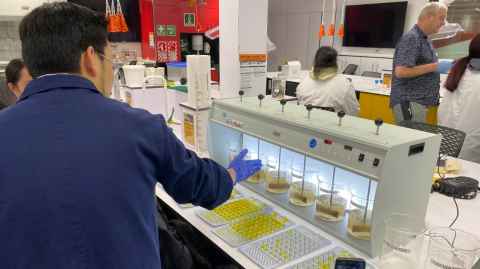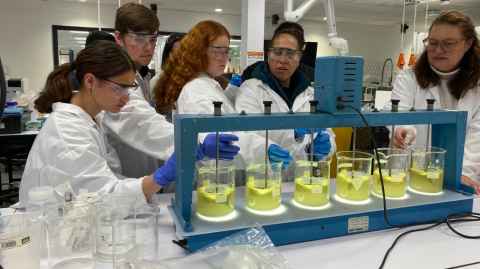University partners with hapū to build freshwater knowledge
3 July 2023
Waipapa Taumata Rau and Winiata marae are working together to improve freshwater quality in the rural town of Taihape.

With the aim of reclaiming freshwater katiakitanga for future generations, Waipapa Taumata Rau, University of Auckland has partnered with Winiata marae in Taihape to combine mātauranga Māori and Western knowledge.
Taihape hapū, Ngāti Hinemanu and Ngāti Paki, experienced degradation in their local water quality and were interested in partnering with the University to monitor the situation.
The partnership has taken freshwater samples from Winiata local rivers since early 2023, including from the Mangaone, Hautapu, and Rangitīkei rivers.
Winiata marae is also setting up a science laboratory on site for water quality testing, with the help of Faculty of Medical and Health Sciences technical services manager Dr Yantao Song who donated 20 microscopes to the project on behalf of the faculty.
The hope is to establish a model that improves water management in the Hautapu and Rangitīkei rivers, both popular spots for water recreation.
Meanwhile, the Faculty of Engineering recently hosted a two-day workshop demonstrating water quality testing methods including turbidity, coliform and E. coli testing, alongside water treatment methods such as coagulation, flocculation and sedimentation to improve water quality.
Samples from the Mangaone, Hautapu and Rangitīkei rivers and their headwaters in the Ruahine Ranges were tested.
The laboratory results revealed upper Mangaone was more polluted than the lower end of Mangaone, which flows by Winiata marae.
“The biological water quality measurements indicate that, at the time of sampling, the water bodies contained indicator microorganisms, such as E. coli,” says Dr Wei-Qin Zhuang, from the Department of Civil and Environmental Engineering.
“It indicates that it is likely safe for recreational activities like swimming, and possibly eating tuna (eel) from these environments if properly cooked, but certainly not suitable for direct consumption.
“The Hautapu and Rangatikei rivers, which the Mangaone river empties into, exhibit lower E. coli levels due to larger volumes of water, leading to a dilution of contaminants but the samples taken don't currently meet the standards for drinking water,” he says.

Winiata marae's Wai Leadership spokesperson, Puti Wilson, says although the area is currently safe for swimming, sewage overflows due to storm events can result in high contamination levels.
“Our most recent samples were taken in mid-June at a time of reasonably high-water flows following recent rainfall but not during or following a significant wet weather event."
Winiata marae kaumātua, Jordan Haines-Winiata, says the marae is also aware of other issues affecting water quality in the area and they are taking a combined Mātauranga and Western science approach to address them.
“Our partnership has allowed us to recognise the need to conduct more frequent and long-term monitoring of water quality to gain a more comprehensive understanding of surface water health, alongside traditional knowledge,” he says.
“This is how Mātauranga and science can really work well together and make a difference. We are also developing key relationship pathways for rural Māori communities, especially rangatahi."
Funding for the marae visit to the University of Auckland laboratories came from Horizons Regional Council and Ministry for the Environment.
The event was facilitated and led by senior lecturer Dr Wei-Qin Zhuang and associate professor Doug Wilson of the Department of Civil and Environmental Engineering, and Dr Shan Yi from the Department of Chemical and Materials Engineering.
Media contact:
Te Rina Triponel | Kaitohutohu Pāpāho Māori
E: te.rina.triponel@auckland.ac.nz